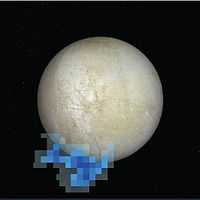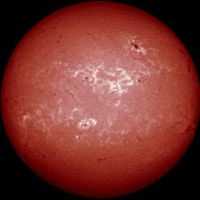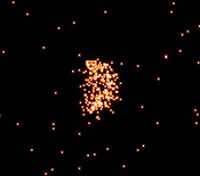Gases/Gaseous objects
< Gases
"This [image at the right] is the first strong evidence of water plumes erupting off Europa's surface."[1]
"Hubble didn't photograph plumes, but spectroscopically detected auroral emissions from oxygen and hydrogen. The aurora is powered by Jupiter's magnetic field. This is only the second moon in the solar system found ejecting water vapor from the frigid surface. The image of Europa is derived from a global surface map generated from combined observations taken by NASA's Voyager and Galileo space probes."[1]
Gases
Def. matter "that can be contained only if it is fully surrounded by a solid (or in a bubble of liquid) (or held together by gravitational pull); it can condense into a liquid, or can (rarely) become a solid directly"[2] is called a gas.
Def. relating "to, or existing as, gas"[3] is called gaseous.
Theoretical gaseous objects
"[T]he evolution of star accretion onto a supermassive gaseous object in the central region of an active galactic nucleus [may be addressed using] a gaseous model of relaxing dense stellar systems".[4]
Sun

Depending primarily upon gas temperature, the presence of gas may be used to determine the composition of the gas object observed, at least the outer layer. Early spectroscopy[5] of the Sun using estimates of "the line intensities of several lines by eye [to derive] the abundances of ... elements ... [concluded] that the Sun [is] largely made of hydrogen."[6]
Venus

The right image is the first X-ray image ever made of Venus. It "shows a half crescent due to the relative orientation of the Sun, Earth and Venus. The X-rays from Venus are produced by fluorescent radiation from oxygen and other atoms in the atmosphere between 120 and 140 kilometers above the surface of the planet."[7] The fluorescent source of the X-rays places Venus in the gas dwarf category even though a rocky object lies some 120 km beneath this layer.
Research
Hypothesis:
- Gaseous objects in the interstellar medium may assume any shape.
Control groups

The findings demonstrate a statistically systematic change from the status quo or the control group.
“In the design of experiments, treatments [or special properties or characteristics] are applied to [or observed in] experimental units in the treatment group(s).[8] In comparative experiments, members of the complementary group, the control group, receive either no treatment or a standard treatment.[9]"[10]
Proof of concept
Def. a “short and/or incomplete realization of a certain method or idea to demonstrate its feasibility"[11] is called a proof of concept.
Def. evidence that demonstrates that a concept is possible is called proof of concept.
The proof-of-concept structure consists of
- background,
- procedures,
- findings, and
- interpretation.[12]
See also
References
- 1 2 L. Roth (12 December 2013). "Water Vapor Over Europa". Greenbelt, Maryland USA: Goddard Space Flight Center. Retrieved 2014-06-11.
- ↑ "gas, In: Wiktionary". San Francisco, California: Wikimedia Foundation, Inc. September 19, 2013. Retrieved 2013-10-05.
- ↑ "gaseous, In: Wiktionary". San Francisco, California: Wikimedia Foundation, Inc. September 29, 2013. Retrieved 2013-10-05.
- ↑ P. Amaro-Seoane and R. Spurzem (2001). J. H. Knapen, J. E. Beckman, I. Shlosman, and T. J. Mahoney. ed. Gas in the Central Regions of AGN: The Interstellar Medium and Supermassive Gaseous Objects, In: The Central Kiloparsec of Starbursts and AGN: The La Palma Connection. 249. San Francisco, California USA: Astronomical Society of the Pacific. pp. 731-4. ISBN 1-58381-089-7. Bibcode: 2001ASPC..249..731A. http://adsabs.harvard.edu/abs/2001ASPC..249..731A. Retrieved 2013-07-16.
- ↑ H. N. Russell (1929). The Astrophysical Journal 70: 11-82.
- ↑ Sarbani Basu and H. M. Antia (March 2008). "HelioseismologyandSolarAbundances". Physics Reports 457 (5-6): 217-83. doi:10.1016/j.physrep.2007.12.002.
- ↑ "File:Venus xray 420.jpg". Wikimedia Commons (San Francisco, California: Wikimedia Foundation, Inc). October 28, 2010. http://commons.wikimedia.org/wiki/File:Venus_xray_420.jpg. Retrieved 2012-08-08.
- ↑ Klaus Hinkelmann, Oscar Kempthorne (2008). Design and Analysis of Experiments, Volume I: Introduction to Experimental Design (2nd ed.). Wiley. ISBN 978-0-471-72756-9. http://books.google.com/?id=T3wWj2kVYZgC&printsec=frontcover.
- ↑ R. A. Bailey (2008). Design of comparative experiments. Cambridge University Press. ISBN 978-0-521-68357-9. http://www.cambridge.org/uk/catalogue/catalogue.asp?isbn=9780521683579.
- ↑ "Treatment and control groups, In: Wikipedia". San Francisco, California: Wikimedia Foundation, Inc. May 18, 2012. Retrieved 2012-05-31.
- ↑ "proof of concept, In: Wiktionary". San Francisco, California: Wikimedia Foundation, Inc. November 10, 2012. Retrieved 2013-01-13.
- ↑ Ginger Lehrman and Ian B Hogue, Sarah Palmer, Cheryl Jennings, Celsa A Spina, Ann Wiegand, Alan L Landay, Robert W Coombs, Douglas D Richman, John W Mellors, John M Coffin, Ronald J Bosch, David M Margolis (August 13, 2005). "Depletion of latent HIV-1 infection in vivo: a proof-of-concept study". Lancet 366 (9485): 549-55. doi:10.1016/S0140-6736(05)67098-5. http://www.ncbi.nlm.nih.gov/pmc/articles/PMC1894952/. Retrieved 2012-05-09.
External links
| |||||||||||||||||||||||||||||||||||
![]() This is a research project at http://en.wikiversity.org
This is a research project at http://en.wikiversity.org
| |
Educational level: this is a research resource. |
| |
Resource type: this resource is an article. |
| |
Resource type: this resource contains a lecture or lecture notes. |
| |
Subject classification: this is a chemistry resource . |